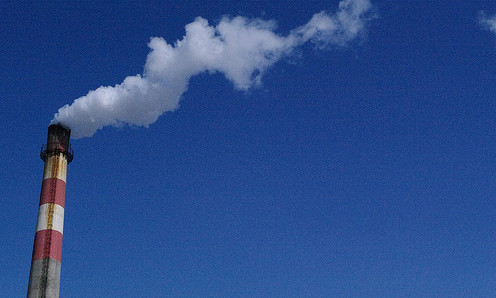Hello, readers! The Supreme Court is on a bit of a break right now, as justices work on opinions and prepare for new oral arguments that will take place on February 24, 25 and 26. As such, I’d like to take this week to preview the case that will be argued on February 24: Utility Air Regulatory Group v. Environmental Protection Agency (henceforth “Utility Air”).
Before I do that, though, I would like to direct everyone’s attention to Attorney General Eric Holder’s plan to expand rights for same-sex couples. For information about this important set of initiatives, read the SCOTUSblog, New York Times, and/or Washington Post articles that detail Holder’s plans. Also, on Friday, February 7, a federal judge in Harrisonburg, Virginia “certified a lawsuit challenging Virginia’s ban on same-sex marriages as class action” (from Virginia Lawyers Weekly). This classification means that “the plaintiffs in the Harrisonburg case will be representing all same-sex couples who want to get married and those who have already been married in other jurisdictions,” making this case a statewide issue. As Attorney General Holder’s plans and the Virginia case unfold, I’ll be sure to keep you posted.
Returning to the case at hand, Utility Air is the latest in a series of cases addressing greenhouse gas emissions. In 2011, the Court unanimously held in American Electric Power v. Connecticut that the Clean Air Act gave the Environmental Protection Agency (“EPA”) the authority to regulate greenhouse gas emissions from power plants. In 2007, the Court ruled in Massachusetts v. EPA that, under the Clean Air Act, the EPA had the authority to regulate carbon dioxide and other greenhouse gases because they were air pollutants. Following the ruling in Massachusetts v. EPA, the EPA “set out a series of standards governing greenhouse gas emissions” (from Oyez). “One of these benchmarks set emission standards for vehicles, while another one required stationary sources of greenhouse gases to obtain constructing and operating permits from the EPA,” and it is the benchmark regarding stationary sources that is now being contested in Utility Air.
Many state and industry groups “challenged these rules on the grounds that they are predicated on an improper construction of the Clean Air Act and are arbitrary and capricious because they are based on an inadequate scientific record” (from Oyez). The Supreme Court will hear several of these cases, such as Texas v. Environmental Protection Agency and American Chemistry Council v. Environmental Protection Agency, on the same day as Utility Air. At the heart of each of these cases, then, is whether the EPA can require permits for “stationary sources of greenhouse gas emissions” (from Oyez), and this question might seem confusing from a constitutional standpoint. Unlike other cases I’ve covered so far this year, our rights as American citizens aren’t being called into question and Congress isn’t being accused of overstepping its bounds.
Instead, a different sort of question is at stake in Utility Air—the regulatory power of the executive branch, under whose auspices the EPA falls. Howard Nielson’s special feature on SCOTUSblog explains the constitutional issues in much greater detail, but put simply, the executive branch does not have the power to make laws—it has only the power to enforce them. In Nielson’s explanation of Utility Air, he quotes a famous line from Youngstown Sheet and Tube Co. v. Sawyer, a case that underscored the divide between executive and legislative branch authorities: “…the president’s power to see that the laws are faithfully executed refutes the idea that he is to be a lawmaker.” This principle that Youngstown helped establish is especially important in Utility Air, because “the EPA has purported to alter… unequivocal numerical thresholds that Congress itself established with specificity in a duly enacted statute” (from SCOTUSblog). Congress, in the Clean Air Act, had already set “numerical thresholds” for acceptable levels of greenhouse gas emissions from stationary sources, and now the Environmental Protection Agency seeks to “increase [those thresholds] by a magnitude of 40 to 100 [sic] times.” “More startling still,” Nielson explains, “the EPA has claimed the power to make additional changes to these statutory thresholds on an ongoing basis.”
So what we have here in Utility Air is a conundrum that pits environmentalists against constitutional scholars: should the EPA be allowed to create whatever regulations it wants in order to decrease harmful greenhouse gas emissions, or should the EPA adhere to the limited powers granted to it by Article II of the Constitution? As Nielson speculates, “the EPA’s action reflects sincere frustration with Congress’ apparent inability or unwillingness to address what many regard as a critical and pressing problem,” and I understand why the EPA wants to make bold moves to stop greenhouse gas emissions. Given Congress’ inaction on environmental issues, the EPA must feel that it has to take matters into its own hands to create any sort of progress on regulating stationary greenhouse gas emissions. However, if the EPA is allowed to make its own rules, does that mean that every Executive Branch agency gets to create statutes when laws passed by Congress do not go far enough (or are not enacted at all)?
I feel conflicted about this issue. I’m concerned about climate change both in the United States and on a global scale, so I agree with the EPA’s goals to regulate stationary greenhouse gas emissions; however, I’m also a student of constitutional law, so I understand why the petitioners in Utility Air are arguing for the enforcement of the Constitution and the precedent set by cases like Youngstown. I’m curious to see what arguments are made by the petitioners and the EPA on February 24, and to read the Court’s decision when it is ultimately released. Until then, read more on the case here at SCOTUSblog’s symposium. And keep your eyes peeled for any developments in the same-sex marriage issues that I mentioned at the beginning of this article.
